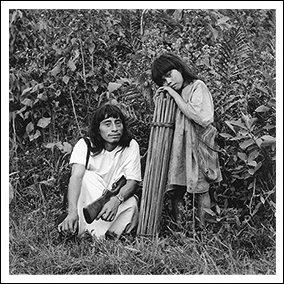The sadly famous Law of the "Brecha Lacandona" was preceded by a series of government's attempts to preserve the selva from destruction caused by logging, cattle breeding, farming, migrating of population and other invasions which threatened its integrity. (Read more...)
Nevertheless, it is known that the first serious attempt to put this exploitation on a regular basis was inspired by a Danish archeologist Frans Blom and his Swiss spouse Gertrude Duby, a famous photographer. They arrived in Chiapas and settled in San Cristobal de las Casas in the 50-s, and while making studies of the Mayan dialect of local Lacandons, they also became friends with the local political elite. Gertrude Duby, in particular, maintained good relationships with then Chiapas governor Manuel Velasco Suarez and future Mexican president Luis Echeverria (these two later prepared the Law of the Brecha Lacandona). As a matter of fact, Frans Blom had a firm conviction that the Selva was able to maintain and feed thousands of people if sustainable farming be developed there with help of government regulations. Both Blom and Gertrude Duby are considered to give the first inspiration to the Law of the Brecha Lacandona as the first act of Government regulation in using natural resources in Chiapas. In reality, the Presidential Decree aimed at "preserving" the natural resources in the selva turned into mere absurdity, and deprived thousands of other indigenous peasants of their homes.
Frans Blom
But the Lacandon jungle and its "uncivilised" settlers, lacandons, were brought to civilisation much earlier, with arrival of the first American evangelists who came there in the thirties (although attempts to establish evangelical missions in Chiapas were known in early 20th century). In early 20th century, Lacandons still confessed their own religion reflecting old Mayan beliefs in spite of all previous attempts by Spanish administration to bring them to Christianity. American evangelists Philip and Mary Baer, also belonging to the Summer Institute of Linguistics, managed not only get Lacandons baptised into protestant confession, but also gathered the dispersed Lacandon families ("caribales") together and concentrate them into three villages in the Selva: Naja and Metzabok in the north of selva, and Lacanja Chansayab in the south, thus making them more "accessible" to civilisators. The Bauer family also trained the local priests among the Lacandons which created a cultural split in the Lacandon community who previously had never identified themselves as the "north" or "south" hach winick ("true people")
Was there a real need to evangelise modern Lacandonds who previously had successfully avoided all Spaniards' attempts to "civilise" them? Didn't evangelists bring along with them a further destruction of the selva, making this destruction just more "regular", with getting Lacandons more "integrated into the nation" (what nation?- Mexican? American?)
American linguist Robert Bruce and Mexican journalist Victor Perera lived among the Lacandon community and published a book "The Last Lords of Palenque". Robert Bruce left the evidence of their contemplations about moral aspects of "white" presence among lacandons, and put forward the core question:
Did Lacandons really need Western interference to feel and live happier?


.jpg)
No comments:
Post a Comment